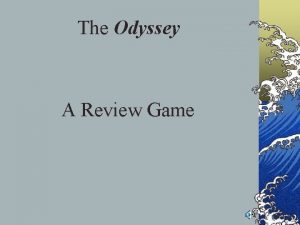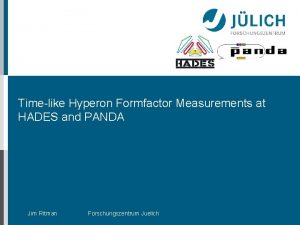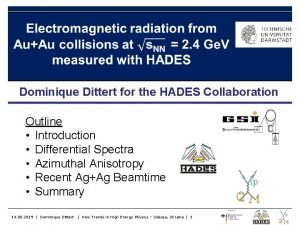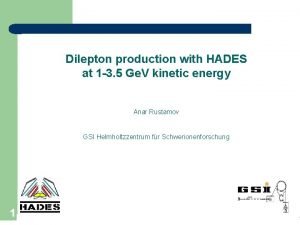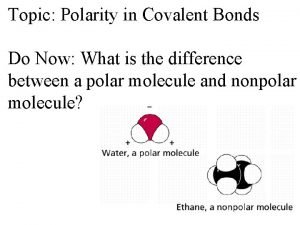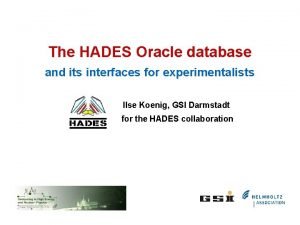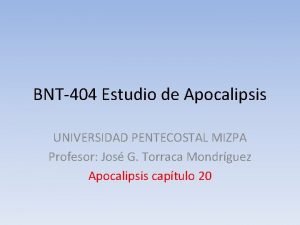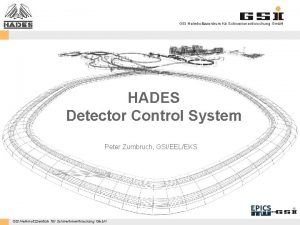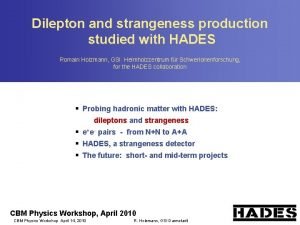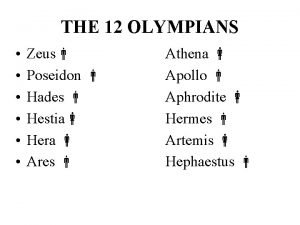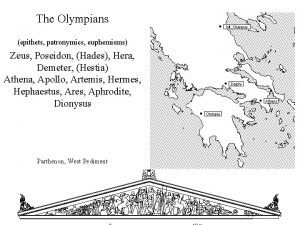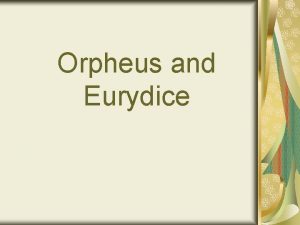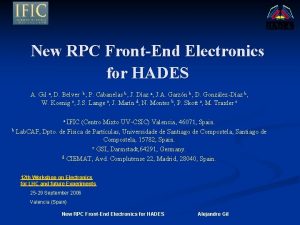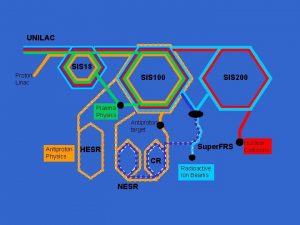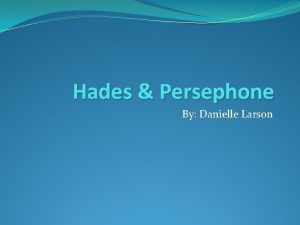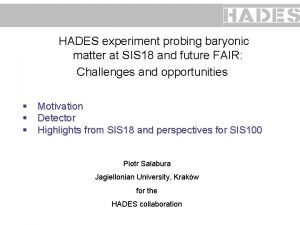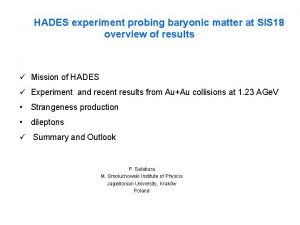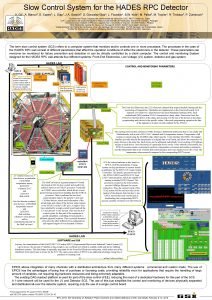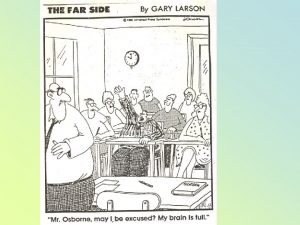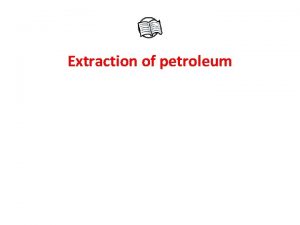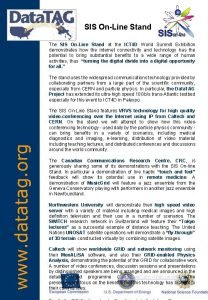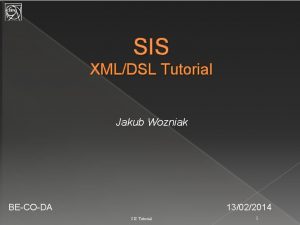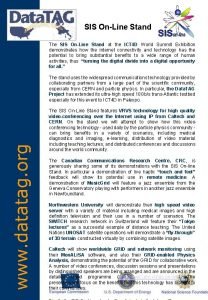Slow extraction input from HADES at SIS 18






































- Slides: 38

Slow extraction – input from HADES at SIS 18 § Introduction and motivation - requirements driven by physics program. § Beam properties measured at HADES focal point • • T 0 and beam monitoring detector in HADES Beam focus, emittance In-spill beam position stability Time structure of the beam § HADES @ SIS 18 future experiments • Pion, proton and HI induced reactions § CBM/HADES at SIS 100 • Experimental setup § Beam quality requirements for CBM/HADES @ SIS 100 Jerzy Pietraszko for the CBM/HADES 1 J. Pietraszko, HIC 4 FAIR Workshop, Darmstadt, February 26 , 2016

Experimental challenges (di-lepton spectroscopy) Benchmark; ω measurement via e+e- channel (ω e+e-) Di-leptons do not undergo strong interaction carry undisturbed information about meson For ω (subthreshold production): - 10 -3 – production probability - 10 -4 – e+e- channel - 10 -1 – acceptance, det efficiency, . . probability to measure one ω about 10 -8 Key issues: 1. High statistic measurements 2. Very clean data low fake contributions 2 J. Pietraszko, HIC 4 FAIR Workshop, Darmstadt, February 26 , 2016

Experimental challenges example for p+Nb bremsstrahlung and background processes low mass detection system Benchmark; ω measurement via e+e- channel (ω e+e-) photon conversion (p+Nb) M( )/M( 0) : 10 -3 0 (100%) e+ e- - conversion Keep bremsstrahlung and photon conversion on the lowest possible level reduce X/X 0 , segmented, small target Target for Au beam: 2. 2 mm diameter , 15 segments perfect beam focus, stable beam position ! 3 J. Pietraszko, HIC 4 FAIR Workshop, Darmstadt, February 26 , 2016

Beam monitoring at HADES/CBM @ SIS 100 Prototype device tested @ SIS 18 1. Multiplicity in the Spectrometer Reaction detection 2. Segmented diamond Start detector Single beam particle detection 4 J. Pietraszko, HIC 4 FAIR Workshop, Darmstadt, February 26 , 2016 4

Start detector for CBM/HADES @ SIS 100 prototype tested at Au+Au (Apr 12) The key features: ü Double-sided multi-strip diamond based sensor for HI (16 channels on each side) ü fast, high rate readout electronics, up to 10 MHz/channel - 16 stripes on each side - strip width: 200µm - gap: 90 µm - det. thickness about 60 µm - dedicated electronics: Multihit TDC (17 ps) Det. resolution : 50 ps Keep bremsstrahlung and photon conversion on the lowest possible level reduce X/X 0 Au target design reconstructed target elements 15 gold targets (Ø 2. 2 mm) 5 J. Pietraszko, HIC 4 FAIR Workshop, Darmstadt, February 26 , 2016

Radiation damage – systematic study for Au beam J. Pietraszkoa, A. Dravenyb , T. Galatyuk, V. Griljc, W. Koeniga, M. Trägera a GSI Helmholtz Centre for Heavy Ion Research Gmb. H Planckstrasse 1, D-64291 Darmstadt, GERMANY b Ecole Centrale de Lyon c Ruđer Bošković Institute, Zagreb d Technische Universität Darmstadt, Germany Fit result to the fluence: seven 2 -dim functions. photo of the metallized sensor before mounting on the PCB IBIC - µBeam scan, Zagreb, Whole detecotr measuered Example ADC IBIC spectra Pre li min corresponding particle flux ary Pre lim inar y J. Pietraszko, HIC 4 FAIR Workshop, Darmstadt, February 26 , 2016

Required size of the beam spot at CBM/HADES @ SIS 100 at least as small as at SIS 18 2. 5 mm (Y) x 1. 9 mm (X) - (6 ! - 99, 7%) J. Pietraszko, HIC 4 FAIR Workshop, Darmstadt, February 26 , 2016

Beam halo at HADES @ SIS 18 ≈103 Beam halo at SIS 18 - Au beam Apr 12 at SIS 100 we need below 10 -5 at 5 mm away from beam axis 8 J. Pietraszko, HIC 4 FAIR Workshop, Darmstadt, February 26 , 2016

Beam position stability during spill - Significant instability of the beam position in X and Y direction at the target point. Mean position change: X: ch 14 -ch 4 ( X ≈ 3. 0 mm !) Y: ch 12 -ch 4 ( Y ≈ 2. 4 mm !) - Several days later - improved beam spot position stability 9 J. Pietraszko, HIC 4 FAIR Workshop, Darmstadt, February 26 , 2016

Beam position stability – day-wise 0. 6 mm day 096 1. 2 mm day 097 1. 2 mm day 098 1. 2 mm day 099 time 1. 8 mm 0. 9 mm day 100 0. 3 mm day 101 0. 3 mm day 102 0. 3 mm day 103 0. 9 mm time day 104 day 105 day 106 day 107 time J. Pietraszko, HIC 4 FAIR Workshop, Darmstadt, February 26 , 2016

Beam position instability – consequences for pion beam - maximal SIS intensity (N beam), - Be target diameter 4 mm loses if the beam is not stable plan to install Be target of 2. 3 mm diameter ! J. Pietraszko, HIC 4 FAIR Workshop, Darmstadt, February 26 , 2016

HADES@SIS 18 – pion beam in 2014 High current experiment in July/August 2014 - In 2014, 400. 000 /spill at 0. 7 Ge. V/c on HADES target were reached with approx. 0. 9*1011 N 2 ions/spill. - Too high radiation level in NE 5 and SIS tunnel (Intensity had to be reduced to 150. 000 /spill): Hottest areas: - extraction area – m. Sv/h - first quadrupole after the septum 1. 5 m. Sv/h (6 weeks after the high int. run) (4 times higher than ever measured at this point) - TH 3 MU 1 – in Jan. 2015 - 60 µSv/h - air activation - for the first time at GSI – more than 1000 Bq/m 3 of Ar-41 outside controlled areas ! 40 days of high current N-beam – 90% of total annual dose in halls TR and EX Dose Measurements at SIS 18 and connected experimental halls TR, EX, TH. T. Radon et al. to be published in GSI annual report. Pion beam planned in HADES in 2018 -. . . improvements needed ! J. Pietraszko, HIC 4 FAIR Workshop, Darmstadt, February 26 , 2016

Time structure of the beam at SIS 18 Beam ions detected in the Start detector, time scale: 1 ms/div 13 J. Pietraszko, HIC 4 FAIR Workshop, Darmstadt, February 26 , 2016

DAQ busy and reaction trigger at 50µs scale 50 us/div Fast reaction trigger signals DAQ Busy signals 14 J. Pietraszko, HIC 4 FAIR Workshop, Darmstadt, February 26 , 2016

DAQ busy and reaction trigger at 100µs scale 100 us/div Fast reaction trigger signals DAQ Busy signals 15 J. Pietraszko, HIC 4 FAIR Workshop, Darmstadt, February 26 , 2016

DAQ busy and reaction trigger at 100µs scale long periods without reaction trigger 100 us/div Unnecessary load on detectors Fast reaction trigger signals 16 DAQ Busy signals J. Pietraszko, HIC 4 FAIR Workshop, Darmstadt, February 26 , 2016

DAQ busy and reaction trigger at 1 ms scale long periods without reaction trigger 1 ms/div Fast reaction trigger signals DAQ Busy signals 17 J. Pietraszko, HIC 4 FAIR Workshop, Darmstadt, February 26 , 2016

Experimental consequences for Au beam 33% of events § -electrons within the detector integration time (140 ns) § unknown T 0 (reaction time) background !! § Reduced performance od the system, § Event rate reduced more than a factor of 3 !!! § Unnecessary load on detectors – radiation damage lifetime reduced 18 J. Pietraszko, HIC 4 FAIR Workshop, Darmstadt, February 26 , 2016

The time structure of the beam – bunched extraction at SS 18 not suited for high rate experiments Beam ions detected in the Start detector, time scale: 1 ms/div, Au beam 1. 25 AGe. V Extraction without bunching Extraction with bunching, SIS 18 Time [ns] Resonator frequency: 5 MHz not usable for CBM at SIS 100 !!!! we would need more than 40 MHz 19 Time [ns] J. Pietraszko, HIC 4 FAIR Workshop, Darmstadt, February 26 , 2016

The time structure of the beam – spill feedback Beam ions detected in the Start detector, time scale: 1 ms/div, Au beam 1. 25 AGe. V Extraction without bunching. J. Pietraszko, HIC 4 FAIR Workshop, Darmstadt, February 26 , 2016

HADES@SIS 18 future experiments primary beams in HADES: p/HI Proton case: Highest proton beam momentum which can be used for stable runs ? 4. 5 Ge. V kinetic beam energy (√s =3. 47 Ge. V) ? Can be used for strangeness production, i. e. Cascade HI case: Moderate primary beam intensities - slow extraction, as long as possible, i. e. around 10 seconds - minimum of rate fluctuations in spill (micro spill structure) - beam intensity: < 107 Ag or Au ions per second in flat top - Very stable beam spot (< 0, 5 mm spread during spill) - Fast micro spill structure monitoring in the beam line - More/better beam diagnostic elements in our beam line reliable and fast beam line setting (without the best experts around) minimum of rate fluctuations in spill (micro spill structure) J. Pietraszko, HIC 4 FAIR Workshop, Darmstadt, February 26 , 2016

CBM/HADES @ SIS 100 – experimental area HADES CBM 22 J. Pietraszko, HIC 4 FAIR Workshop, Darmstadt, February 26 , 2016

CBM/HADES @ SIS 100 – beam line aperture 23 J. Pietraszko, HIC 4 FAIR Workshop, Darmstadt, February 26 , 2016

CBM @ SIS 100 – beam emittance requirements 1. Requested beam spot at the CBM target point should be smaller than 2 mm in diameter in both directions (99. 73 % of the beam) for beam energies above 4 AGe. V. 2. CBM beam divergence: The beam divergence in case of the CBM experiment is fixed and constrained by a long distance between the last focusing magnet and the focal point which is 17 meters. Only 70% of the beam line aperture will be filled. Based on fixed geometrical constrain the beam divergence can not be larger than 6 mrad. 3. The CBM beam line aperture: the smallest opening in the CBM beam line is located at the first MVD plane, at the distance of 10. 0 cm from the focal point, and is 1. 0 cm in diameter. The beam line aperture in front of CBM target is fixed and is 15 cm. 4. The requested beam emittance is constrained by the beam divergence (6 mrad) and small beam diameter at the target point, 2 mm at 4 AGe. V. Thus, the beam emittance should be 3 mrad * 1 mm = 3. 0 mm mrad at 4 AGe. V. 5. The BEAM HALO around the CBM focal point should be reduced below 10 -5 of the total beam intensity at a distance greater than 5 mm away the beam symmetry axis. 24 J. Pietraszko, HIC 4 FAIR Workshop, Darmstadt, February 26 , 2016

HADES @ SIS 100 – beam emittance requirements 1. Beam spot at the focal point of HADES should be smaller than 2 mm in diameter in vertical and in horizontal directions. The beam spot should contain 99. 73 % of the beam. 2. FWall detector is located 7 meters downstream of the target. The beam line hole in this detector is 7 cm in diameter. 3. The beam aperture in front of the HADES target is 15 cm in diameter. 4. The beam emittance, constrained by the beam hole in the FWall detector and small beam spot, should be 5 mrad * 1 mm = 5 mrad mm at 2 AGe. V. 5. Presence of HALO particles around the HADES focal point should be kept below 10 -5 of the total beam intensity at a distance greater than 5 mm away the beam symmetry axis. 25 J. Pietraszko, HIC 4 FAIR Workshop, Darmstadt, February 26 , 2016

CBM/HADES @ SIS 100 – ion intensities/energies (slow extraction, 10 s long spill) 26 J. Pietraszko, HIC 4 FAIR Workshop, Darmstadt, February 26 , 2016

CBM/HADES @ SIS 100 – beam abort system - missing part of the SIS 18 system Motivation: d. E/dx Z 2 of the particle charge Examples for Au ion @ 1. 2 A Ge. V, d. E/dx is 4. 46 Me. V/µm in diamond. for proton @ 1. 2 Ge. V, d. E/dx is 0. 00056 Me. V/µm Almost four orders of magnitudes difference !!!! Any accidental irradiation by direct beam ions can damage the detection system components and has to be avoided. A fast, fail-safe, beam abort system is requested for the SIS 100/300 accelerator. Block the beam transport to the HADES/CBM experimental area within 100200µs time and should be triggered by the beam abort signal delivered by a dedicated detection system from the experiments. the abort system in included in the SIS 100 design 27 J. Pietraszko, HIC 4 FAIR Workshop, Darmstadt, February 26 , 2016

Summary ü Precise beam diagnostic at the experimental focal point: at SIS 18 – exist, at SIS 100 will be provided ü Significant data quality loses because of micro-spill structure and beam instability Needs improvements at SIS 18 for planned HADES experiments ! Should be avoided at SIS 100 Reduced data quality and rate capability ! Load on detectors ! Impossible to run CBM @ 107 interactions/s (109 ions/s) ! ü Beam requirements for CBM@SIS 100 based on realistic SIS 18 results. ü Beam abort system essential for safe detector operation at SIS 100 28 J. Pietraszko, HIC 4 FAIR Workshop, Darmstadt, February 26 , 2016

29 J. Pietraszko, HIC 4 FAIR Workshop, Darmstadt, February 26 , 2016

30 J. Pietraszko, HIC 4 FAIR Workshop, Darmstadt, February 26 , 2016

Requirement for time structure of the beam at SIS 100 – has to be significantly better than at SIS 18 Beam ions detected in the Start detector, time scale: 1 ms/div 31 J. Pietraszko, HIC 4 FAIR Workshop, Darmstadt, February 26 , 2016

DAQ busy and reaction trigger at 1 ms scale long periods without reaction trigger 1 ms/div Fast reaction trigger signals DAQ Busy signals 32 J. Pietraszko, HIC 4 FAIR Workshop, Darmstadt, February 26 , 2016

Start Cal level, everything in ns. 33 J. Pietraszko, HIC 4 FAIR Workshop, Darmstadt, February 26 , 2016

Bunched beam Standard beam extraction 34 J. Pietraszko, HIC 4 FAIR Workshop, Darmstadt, February 26 , 2016

HADES@SIS 18 (before SIS 100 era) – experimental strategy - Request one run per year with a minimum of four weeks beam on target for production, high statistics and precision measurements - Rare probes (strangeness, dileptons) - Excitation functions (beam energy scans) - Long set-up times of the experiment, mainly beam transport and optimization - how this can be reduced ? - Major statistics and data quality losses due to: - parasitic users - changes in UNILAC settings seem to influence extraction efficiencies - ion source changes during a run - No production experiment request before second half of 2018 - Upgrades not finished before 35 J. Pietraszko, HIC 4 FAIR Workshop, Darmstadt, February 26 , 2016

HADES@SIS 18 – pion beam in 2014 High current experiment in July/August 2014 In 2014, 400. 000 /spill at 0. 7 Ge. V/c on HADES target were reached with approx. 0. 9*1011 N 2 ions/spill. Too high radiation level in NE 5 and SIS tunnel (Intensity had to be reduced to 150. 000 /spill): Hottest areas: - extraction area – m. Sv/h - first quadrupole after the septum – 1. 5 m. Sv/h (6 weeks after the high int. run) (4 times higher than ever measured at this point) - TH 3 MU 1 – in Jan. 2015 - 60 µSv/h - air activation - for the first time at GSI - more than 1000 Bq/m 3 of Ar-41 outside controlled areas ! - 40 days of high current N-beam – 90% of total annual dose in halls TR and EX Dose Measurements at SIS 18 and connected experimental halls TR, EX, TH. T. Radon et al. to be published in GSI annual report. 36 J. Pietraszko, HIC 4 FAIR Workshop, Darmstadt, February 26 , 2016

HADES@SIS 18 – feature goals for pion beam at SIS 18 Goal: maximize - flux on the HADES target Current limitations come from radiation issues, therefore: • optimize extraction efficiency - what can be done to substantially increase this efficiency? • optimize transfer line efficiency • enlarge aperture where necessary • reduce activation of magnets in front of the pion production target • improve on shielding of magnets in NE 5 • improve substantially on the shielding of the NE 5 roof (includes redoing the water cooling solder joints of the magnets in the pion production cave) • better and more granular monitoring of the radiation level • better beam line monitoring • diagnostic of beam profile near the production target • improve predictions from Mirco to calculate the beam line settings Stable running conditions with respect to radiation safety alarms Dual harmonics, More bunches in SIS at space charge limit HADES beam line controllable with new control software Is there successor of MIRCO ? 37 J. Pietraszko, HIC 4 FAIR Workshop, Darmstadt, February 26 , 2016

HADES@SIS 18 – primary beams in HADES: p/HI Proton case: Highest proton beam momentum which can be used for stable runs In theory it should be 0. 3× 18 = 5. 4 Ge. V/c corresponding to 4. 5 Ge. V kinetic beam energy (√s =3. 47 Ge. V) Can be used for strangeness production, i. e. Cascade HI case: Moderate primary beam intensities slow extraction, as long as possible, i. e. around 10 seconds but with the requirement of a minimum of rate fluctuations in spill (micro spill structure) • beam intensity: < 107 Ag or Au ions per second in flat top • Very stable beam spot (< 0, 5 mm spread during spill) • Fast micro spill structure monitoring in the beam line (without using HADESdetectors). • More/better beam diagnostic elements in our beam line reliable and fast beam line setting (without the best experts around) 38 J. Pietraszko, HIC 4 FAIR Workshop, Darmstadt, February 26 , 2016
 Copyright
Copyright Finely tuned input and roughly tuned input
Finely tuned input and roughly tuned input Input peripheral devices
Input peripheral devices Hades game odysseus
Hades game odysseus What is the name of the image
What is the name of the image Hades construction
Hades construction Hades flaws
Hades flaws Hades outline
Hades outline Hades roman name
Hades roman name Hades sender
Hades sender żona hadesa
żona hadesa Why can’t percy simply fight crusty?
Why can’t percy simply fight crusty? Hades segun la biblia
Hades segun la biblia Características generales de hades
Características generales de hades Pluto greek name
Pluto greek name Hades dls
Hades dls Odysseus travels
Odysseus travels Iris goddess symbol
Iris goddess symbol Greatest polarity
Greatest polarity Hades database
Hades database Hera goddess
Hera goddess Hades paradise
Hades paradise Gog y magog mapa
Gog y magog mapa Hades
Hades Gsi
Gsi Domain of hades
Domain of hades Hades helment
Hades helment Hades romain
Hades romain Hades pp
Hades pp Hera interesting facts
Hera interesting facts Like christ
Like christ Children of hera
Children of hera Epithets of poseidon
Epithets of poseidon Hades who is the narrator
Hades who is the narrator God of loneliness greek
God of loneliness greek Hades roman name
Hades roman name Aphrodite roman name and symbol
Aphrodite roman name and symbol Planets named after gods
Planets named after gods Hades gil
Hades gil



